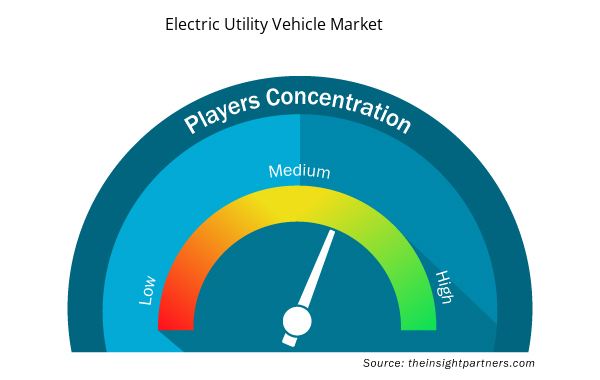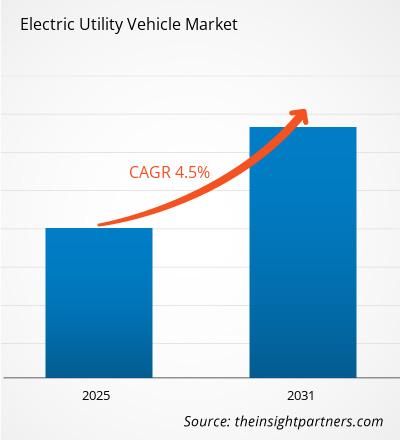電気ユーティリティ車両市場は、 2023年から2031年にかけて4.5%のCAGRを記録し、市場規模は2023年のXX百万米ドルから2031年にはXX百万米ドルに拡大すると予想されています。
電気ユーティリティ車両市場は、バッテリータイプ(リチウムイオン、鉛蓄電池、その他)、駆動タイプ(二輪駆動、四輪駆動)、速度(時速25マイルまで、時速26~45マイル、時速45マイル以上)、用途(鉱業、建築・建設、スポーツ、農業、ゴルフ場、商業、その他)別に分析しています。
報告書の目的
The Insight Partners による電気ユーティリティ車両市場レポートは、現在の状況と将来の成長、主な推進要因、課題、機会を説明することを目的としています。これにより、次のようなさまざまなビジネス関係者に洞察が提供されます。
- テクノロジープロバイダー/メーカー: 進化する市場の動向を理解し、潜在的な成長機会を把握することで、情報に基づいた戦略的意思決定が可能になります。
- 投資家: 市場の成長率、市場の財務予測、バリュー チェーン全体に存在する機会に関する包括的な傾向分析を実施します。
- 規制機関: 市場の濫用を最小限に抑え、投資家の信用と信頼を維持し、市場の完全性と安定性を維持することを目的として、市場における政策と警察活動を規制します。
電気ユーティリティー車両市場のセグメンテーション
電池のタイプ
- リチウムイオン
- 鉛蓄電池
- その他
ドライブタイプ
- 二輪駆動
- 四輪駆動
スピード
- 最高時速25マイル
- 時速26~45マイル
- 時速45マイル以上
応用
- 鉱業
- 建築・建設
- スポーツ
- 農業
- ゴルフコース
- コマーシャル
- その他
応用
- 鉱業
- 建築・建設
- スポーツ
- 農業
- ゴルフコース
- コマーシャル
- その他
要件に合わせてレポートをカスタマイズする
このレポートの一部、国レベルの分析、Excelデータパックなど、あらゆるレポートを無料でカスタマイズできます。また、スタートアップや大学向けのお得なオファーや割引もご利用いただけます。
- このレポートの主要な市場動向を入手してください。この無料サンプルには、市場動向から見積もりや予測に至るまでのデータ分析が含まれます。
電気自動車市場の成長要因
- 産業部門の急速な拡大: 世界中で産業部門が急速に拡大していることが、市場の成長の大きな原動力となっています。自動車メーカーが炭素排出ゼロの自動車にますます注目していることが、市場の成長を牽引しています。インド ブランド エクイティ財団によると、インドの工業製造部門は 2026 年までに 1 兆米ドルに達すると予想されています。産業開発のこのような成長に伴い、電気自動車の需要が急速に高まっています。
- EV インフラに対する規制支援: 政府は、電気自動車の導入を支援するために、EV 充電インフラの拡張にも投資しています。これらの投資により、高速で効率的な充電ソリューションへの広範なアクセスが確保され、車両運行会社や消費者の参入障壁が下がります。
電気自動車市場の将来動向
- 技術の進歩: 主要企業による先進技術に基づく電気自動車モデルの開発が進むことで、市場には十分なチャンスが生まれています。たとえば、2023 年 3 月には、世界有数の小型ホイールゼロエミッション電気自動車メーカーである Club Car が、最新の公道走行可能な電気自動車である Club Car Urban LSV および XR を発売します。これらは現在、北米の当社の商用販売代理店ネットワークを通じて入手できます。新しい Urban プラットフォームは、数十年にわたって商用市場で目立ってきた Club Car の主要な電気自動車ポートフォリオを拡大します。自動車のスタイリング、人間工学に基づいたデザイン、道路での使用における最高速度 25 mph、特定のニーズに合わせて車両をカスタマイズする機能を備えた新しい Club Car Urban は、大規模なキャンパス、ラストマイル配送、自治体、ホスピタリティ スペースのニーズに対応する独自のユーティリティ ビークル ソリューションを提供します。(企業 Web サイト ニュース)
- バッテリー技術の向上: 電気ユーティリティ車両市場の主要な推進要因の 1 つは、リチウムイオン バッテリー技術の急速な進歩です。バッテリー化学の革新により、エネルギー密度、充電速度、コスト効率が向上し、電気自動車の性能と手頃な価格が直接向上しました。バッテリー価格が下がり続けるにつれて、電気ユーティリティ車両は内燃機関車に対して競争力が高まっています。
電気自動車の市場機会
- 都市部での需要の高まり: 都市部での配送サービスに対する需要の高まり、廃棄物管理用のユーティリティ ビークルに対する需要の高まり、公共交通機関に対する需要の高まりにより、市場の成長に十分な機会が生まれると予想されます。さらに、電気ユーティリティ ビークルは、地方自治体、スポーツ機関などで広く使用されています。
- 車両からグリッドへの (V2G) とスマート充電への重点の高まり: 電気自動車がスマート グリッド テクノロジーと統合されるにつれて、車両からグリッドへの (V2G) システムとスマート充電ソリューションの機会が拡大しています。これらのテクノロジーにより、電気自動車はグリッドから電力を引き出すだけでなく、需要のピーク時にエネルギーを返すことができるため、車両オペレーターに潜在的な節約をもたらし、エネルギー グリッドの安定性に貢献します。
電気ユーティリティー車両市場の地域別洞察
予測期間を通じて電気ユーティリティ車両市場に影響を与える地域的な傾向と要因は、Insight Partners のアナリストによって徹底的に説明されています。このセクションでは、北米、ヨーロッパ、アジア太平洋、中東、アフリカ、南米、中米にわたる電気ユーティリティ車両市場のセグメントと地理についても説明します。

- 電気自動車市場の地域別データを入手
電気自動車市場レポートの範囲
| レポート属性 | 詳細 |
|---|---|
| 2023年の市場規模 | XX百万米ドル |
| 2031年までの市場規模 | XX百万米ドル |
| 世界のCAGR(2023年~2031年) | 4.5% |
| 履歴データ | 2021-2022 |
| 予測期間 | 2024-2031 |
| 対象セグメント | バッテリータイプ別
|
| 対象地域と国 | 北米
|
| 市場リーダーと主要企業プロフィール |
|
電気ユーティリティ車両市場のプレーヤー密度:ビジネスダイナミクスへの影響を理解する
電気ユーティリティ車両市場は、消費者の嗜好の変化、技術の進歩、製品の利点に対する認識の高まりなどの要因により、エンドユーザーの需要が高まり、急速に成長しています。需要が高まるにつれて、企業は提供を拡大し、消費者のニーズを満たすために革新し、新たなトレンドを活用し、市場の成長をさらに促進しています。
市場プレーヤー密度とは、特定の市場または業界内で活動している企業または会社の分布を指します。これは、特定の市場スペースに、その市場規模または総市場価値に対してどれだけの競合相手 (市場プレーヤー) が存在するかを示します。
電気ユーティリティー車両市場で事業を展開している主要企業は次のとおりです。
- アメリカンランドマスター
- ビンテリ電気自動車
- ディア・アンド・カンパニー
- インガソル・ランド
- マーシェルグリーンパワー株式会社
免責事項:上記の企業は、特定の順序でランク付けされていません。

- 電気ユーティリティー車両市場のトップキープレーヤーの概要を入手
主なセールスポイント
- 包括的なカバレッジ: レポートでは、電気ユーティリティ車両市場の製品、サービス、タイプ、エンドユーザーの分析を包括的にカバーし、全体的な展望を提供します。
- 専門家による分析: レポートは、業界の専門家とアナリストの深い理解に基づいてまとめられています。
- 最新情報: このレポートは、最新の情報とデータの傾向を網羅しているため、ビジネスの関連性を保証します。
- カスタマイズ オプション: このレポートは、特定のクライアント要件に対応し、ビジネス戦略に適切に適合するようにカスタマイズできます。
したがって、電気ユーティリティ車両市場に関する調査レポートは、業界のシナリオと成長の見通しを解読し理解する道の先導役となる可能性があります。正当な懸念事項がいくつかあるかもしれませんが、このレポートの全体的な利点は欠点を上回る傾向があります。
- 過去2年間の分析、基準年、CAGRによる予測(7年間)
- PEST分析とSWOT分析
- 市場規模価値/数量 - 世界、地域、国
- 業界と競争環境
- Excel データセット


- Non-Emergency Medical Transportation Market
- Biopharmaceutical Tubing Market
- Transdermal Drug Delivery System Market
- 3D Mapping and Modelling Market
- Adaptive Traffic Control System Market
- Machine Condition Monitoring Market
- Nuclear Decommissioning Services Market
- Military Rubber Tracks Market
- Dry Eye Products Market
- Industrial Inkjet Printers Market

Report Coverage
Revenue forecast, Company Analysis, Industry landscape, Growth factors, and Trends

Segment Covered
This text is related
to segments covered.

Regional Scope
North America, Europe, Asia Pacific, Middle East & Africa, South & Central America

Country Scope
This text is related
to country scope.
よくある質問
Some of the customization options available based on the request are an additional 3-5 company profiles and country-specific analysis of 3-5 countries of your choice. Customizations are to be requested/discussed before making final order confirmation, as our team would review the same and check the feasibility.
The report can be delivered in PDF/PPT format; we can also share excel dataset based on the request.
The major players in the market includes Polaris, Club Car, Toyota Industries Corporation, Deere & Company, Textron, Alke, Renault Group, Briggs & Stratton, Rivian, Columbia Vehicle Group Inc.
The Electric Utility Vehicles Market is estimated to witness a CAGR of 4.5% from 2023 to 2031
The high manufacturing cost for electric utility vehicles hinders the market growth.
The major factors driving the Electric Utility Vehicles Market are: Increasing sale of electric vehicles with government support and initiatives drives the market growth.
Trends and growth analysis reports related to Automotive and Transportation : READ MORE..
The List of Companies
1. American LandMaster
2. Bintelli Electric Vehicles
3. Deere and Company
4. Ingersoll-Rand plc
5. Marshell Green Power Co. Ltd
6. Polaris Inc.
7. Suzhou Eagle Electric Vehicle Manufacturing Co., Ltd
8. Textron Inc.
9. The Toro Company
10. Yamaha Motor Co., Ltd.
The Insight Partners performs research in 4 major stages: Data Collection & Secondary Research, Primary Research, Data Analysis and Data Triangulation & Final Review.
- Data Collection and Secondary Research:
As a market research and consulting firm operating from a decade, we have published and advised several client across the globe. First step for any study will start with an assessment of currently available data and insights from existing reports. Further, historical and current market information is collected from Investor Presentations, Annual Reports, SEC Filings, etc., and other information related to company’s performance and market positioning are gathered from Paid Databases (Factiva, Hoovers, and Reuters) and various other publications available in public domain.
Several associations trade associates, technical forums, institutes, societies and organization are accessed to gain technical as well as market related insights through their publications such as research papers, blogs and press releases related to the studies are referred to get cues about the market. Further, white papers, journals, magazines, and other news articles published in last 3 years are scrutinized and analyzed to understand the current market trends.
- Primary Research:
The primarily interview analysis comprise of data obtained from industry participants interview and answers to survey questions gathered by in-house primary team.
For primary research, interviews are conducted with industry experts/CEOs/Marketing Managers/VPs/Subject Matter Experts from both demand and supply side to get a 360-degree view of the market. The primary team conducts several interviews based on the complexity of the markets to understand the various market trends and dynamics which makes research more credible and precise.
A typical research interview fulfils the following functions:
- Provides first-hand information on the market size, market trends, growth trends, competitive landscape, and outlook
- Validates and strengthens in-house secondary research findings
- Develops the analysis team’s expertise and market understanding
Primary research involves email interactions and telephone interviews for each market, category, segment, and sub-segment across geographies. The participants who typically take part in such a process include, but are not limited to:
- Industry participants: VPs, business development managers, market intelligence managers and national sales managers
- Outside experts: Valuation experts, research analysts and key opinion leaders specializing in the electronics and semiconductor industry.
Below is the breakup of our primary respondents by company, designation, and region:

Once we receive the confirmation from primary research sources or primary respondents, we finalize the base year market estimation and forecast the data as per the macroeconomic and microeconomic factors assessed during data collection.
- Data Analysis:
Once data is validated through both secondary as well as primary respondents, we finalize the market estimations by hypothesis formulation and factor analysis at regional and country level.
- Macro-Economic Factor Analysis:
We analyse macroeconomic indicators such the gross domestic product (GDP), increase in the demand for goods and services across industries, technological advancement, regional economic growth, governmental policies, the influence of COVID-19, PEST analysis, and other aspects. This analysis aids in setting benchmarks for various nations/regions and approximating market splits. Additionally, the general trend of the aforementioned components aid in determining the market's development possibilities.
- Country Level Data:
Various factors that are especially aligned to the country are taken into account to determine the market size for a certain area and country, including the presence of vendors, such as headquarters and offices, the country's GDP, demand patterns, and industry growth. To comprehend the market dynamics for the nation, a number of growth variables, inhibitors, application areas, and current market trends are researched. The aforementioned elements aid in determining the country's overall market's growth potential.
- Company Profile:
The “Table of Contents” is formulated by listing and analyzing more than 25 - 30 companies operating in the market ecosystem across geographies. However, we profile only 10 companies as a standard practice in our syndicate reports. These 10 companies comprise leading, emerging, and regional players. Nonetheless, our analysis is not restricted to the 10 listed companies, we also analyze other companies present in the market to develop a holistic view and understand the prevailing trends. The “Company Profiles” section in the report covers key facts, business description, products & services, financial information, SWOT analysis, and key developments. The financial information presented is extracted from the annual reports and official documents of the publicly listed companies. Upon collecting the information for the sections of respective companies, we verify them via various primary sources and then compile the data in respective company profiles. The company level information helps us in deriving the base number as well as in forecasting the market size.
- Developing Base Number:
Aggregation of sales statistics (2020-2022) and macro-economic factor, and other secondary and primary research insights are utilized to arrive at base number and related market shares for 2022. The data gaps are identified in this step and relevant market data is analyzed, collected from paid primary interviews or databases. On finalizing the base year market size, forecasts are developed on the basis of macro-economic, industry and market growth factors and company level analysis.
- Data Triangulation and Final Review:
The market findings and base year market size calculations are validated from supply as well as demand side. Demand side validations are based on macro-economic factor analysis and benchmarks for respective regions and countries. In case of supply side validations, revenues of major companies are estimated (in case not available) based on industry benchmark, approximate number of employees, product portfolio, and primary interviews revenues are gathered. Further revenue from target product/service segment is assessed to avoid overshooting of market statistics. In case of heavy deviations between supply and demand side values, all thes steps are repeated to achieve synchronization.
We follow an iterative model, wherein we share our research findings with Subject Matter Experts (SME’s) and Key Opinion Leaders (KOLs) until consensus view of the market is not formulated – this model negates any drastic deviation in the opinions of experts. Only validated and universally acceptable research findings are quoted in our reports.
We have important check points that we use to validate our research findings – which we call – data triangulation, where we validate the information, we generate from secondary sources with primary interviews and then we re-validate with our internal data bases and Subject matter experts. This comprehensive model enables us to deliver high quality, reliable data in shortest possible time.


 このレポートの無料サンプルを入手する
このレポートの無料サンプルを入手する